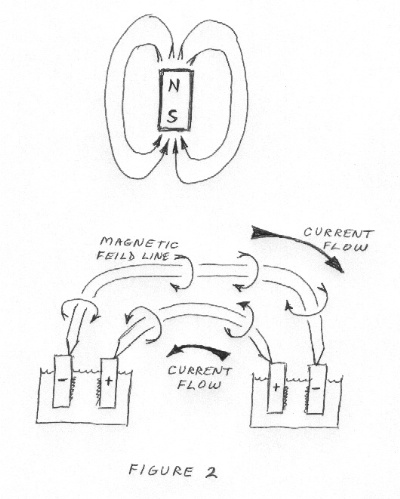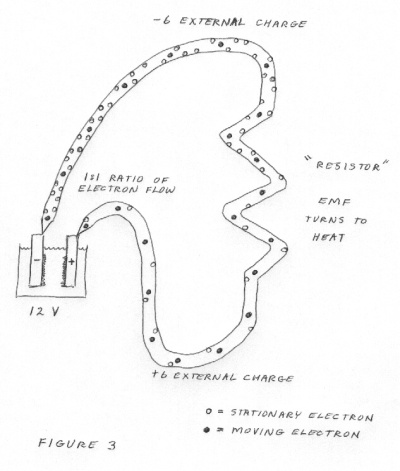

JoeGadget's
Technical Page -2nd Edition
This edition of the page is devoted to understanding electricity's behavior at the electron level. The following writings are a collection of known and accepted theories and observations about electricity. They are collected and presented in this way to help see the 'real' existence of electricity. The explanation does not require math. It is an attempt to see how DC electricity turns into RF waves.
Electricity. What is it ? It is a type of energy. It appears to take several different forms. The analogies that we use to understand it mislead us. The water in a pipe comparison would be more accurate if the model system has a vacuum source as well as a pressure source. To correct this intuitive model there is a method from transistor studies called the hole theory. This theory can be applied to a piece of wire just as well to help see to Electro Motive Force at work. As with all other forms of energy EMF seeks to dissipate or spread out. It seeks to be radio waves getting thinner as they spread out in space. It seeks to be heat so it can do a similar escape from its confinement or concentration. When a battery does something, the amount of energy used still exists in a new form somewhere. The electrons used remain with the battery. The EMF makes a vacuum source for electrons as well as a pressure source. It has to maintain total charge neutrality at all times, or exhibit a net charge to dissipate. If you think of electrons it is accurate to say that EMF comes from and goes from the two terminals. It is from both.
The Hole Theory is a method to study electron flow using electrons as charge carriers. The ion flow method usually applies only to rare situations. One of those situations ( a battery charging another battery ) is best to introduce to hole theory with. The reason is because it separates positive and negative terminal activity into unique events instead of a mere circle for a uniform flow of electrons to complete. You need to see electricity this way to follow the trail into the RF explanations. At that time the pressure part of the idea helps understand how a field builds up but it is the vacuum side that makes the field collapse. They are like a matched pair.
For the following ideal model situation a few facts need to be disregarded in advance. There is electron flow inside batteries being charged. It is called leakage current. It is quite substantial. It is what makes the heat when a battery charges. However, heat is all that it makes. That heat is a loss of energy from the electric circuit and is therefore ignored. In all of the relevant examples where that happens add a heat dissipating resistor to show those losses when you need to consider the total real circuit. The ideal batteries have only a tiny voltage difference between them and they have no internal resistance. This may be done with real batteries but the real internal resistance turns most of the would be 'charge' into heat. An ideal battery may be viewed like a charged capacitor with a few minor changes. The terminal voltage of an ideal battery is constant. A capacitor voltage goes up and down with charge content. The ideal battery converts energy to chemical energy to store it. That's why electrons can flow to & from it without changing the voltage.


For this model to show the Hole Theory view we shall use water molecules in a pipe to represent electrons in a wire. The pipe is of special interest. If compressed it makes a +magnetic pole. If stretched it makes a -magnetic pole. These poles are the same as north and south poles except for the direction of the magnetic current flow. We'll get to that later. For now picture the wires ( pipes ) as extremely rigid constant volume waterways. Figure 1 shows two ideal batteries connected in parallel. One is charging the other and there is no electron flow inside the batteries themselves.
The wire connected to the negative terminal of the source battery gets an electron forced into it. It is electron pressurized and, because it seeks to maintain a neutral charge itself, the wire seeks to force another electron off somewhere else to balance itself out. That energy bearing electron goes into the battery being charged. It is being pushed from the negative terminal. It is also being pulled by the positive terminal. It cannot go somewhere else. At this point it ceases to be an electron in a flow. It is converted to chemical energy. No more electron flow inside the battery. The energy it carried goes into the battery and takes a different form.
At the same time, the positive terminal of the source battery has taken electrons from its wire ( pipe ). The wire has an electron vacuum. The wire seeks to take electrons from somewhere to balance its net electrical charge. It takes them from the battery being charged. By doing so energy goes into the battery as the electrons are going out. The EMF is again converted to chemical energy. If you imagine that the pipe ( wire ) is so rigid that it cannot flex at all then there must be an empty spot inside of it where the water ( electron ) was. That concept is the hole theory at work. It shows you an electron flow from a vacuum point of view instead of pressure.
The Hole Theory needs to be used twice to get a better sense of the pressure & vacuum effect. Replace the battery being charged up in the example with a resistor. The usual picture of electrons being pressurized at the negative terminal comes to mind. Imagine that effect reaches all the way through the resistor to the positive terminal as you usually do. Now create a second mirror image of the circuit using a vacuum source at the positive terminal instead of a pressure source at the negative terminal. That vacuum reaches through the resistor to the negative terminal. For the grand finale imagine both pictures at the same time. It should look something like figure 3.

This is not a redundant way to look at electricity. When we get to RF generation these two pictures will not be overlapping as they are now. Be able to look at a circuit in this dual way. In RF the explanation will explain � of the circuit in terms of pressure for above ground electron flows and the other � in terms of vacuum for below ground flows. The two flows will be 'identical' except for how you picture them. After you study the 1st half you will know what the second half is doing in this 'round about' way. This is necessary because the RF energy appears at two points simultaneously. The +phase side will act as the pressure source, the -phase side as the vacuum source. That point of creation is the point where the RF energy simply appears. When it comes into existence it is like 2 separate batteries appear at that point. Each has a terminal connected to a neutral ground point.
These special RF batteries use the same wire as the electricity that caused them to exist with one exception. The RF voltage and amperage are on the outside of the wire. This is so because the wire is still holding onto its charge neutrality with atomic strength. The RF energy includes its own EMF source. When the RF energy bubble ( � wave ) tries to pressurize one point on a wire and 'vacuumize' another point on the same wire the resultant current flow makes a magnetic field in the wire that opposes its own magnetic field. It therefore keeps itself out of the wire. Its attempts to flow inside the wire are 'reflected' out. The conductivity of the wire attracts the RF to flow through it, as opposed to flowing through space. The wire has a lower impedance path for the RF energy. It cannot enter but it won't quit trying.
The EMF sources in circuits only try to use electron flows for their own discharge. They do not help each other even when they have a common path. When EMF finds release as RF energy it becomes its own circuit. It must maintain charge neutrality just as a solid circuit does. When RF energy is released from a balanced source the +phase side and the -phase side are independent of each other, unlike the positive and negative terminals of a battery. The phases are actually identical in composition with the exception of a � wavelength of distance.
The electricity inside the wire is bound to stay inside the wire because it must respond to its EMF source, the battery. It is bound by electron carriers that take exactly as much static charge as they give. The RF energy is the purest form of electricity. It has no electrons involved. It is pure EMF. It is like a pendulum. It alternates between Electro Force ( voltage ) and Motive Force ( magnetic ). Before we go too much further with RF energy let's take a close look at magnetism. When you see its origins you see that it is merely charge of a slightly different form. Then you will be ready for that final path from AC current to RF radiation at the antenna.